Crafting it in Bonn
Over the last few months, some friends and I have started a Minecraft server together, and it went exactly how one could expect when a group of engineers play a sandbox game. Some of us (myself included) played much more than others and pursued ambitious construction projects that took an obscene amount of time. We also had different experience levels with playing Minecraft, so we all progressed at very different speeds. Nevertheless, everybody’s creativity got a chance to shine through our unique building and playing styles.
During our playthrough, we wanted to build functional infrastructure and inspired historical architecture. We each built bases for ourselves with different goals in mind.
Brühl
After a trip to the small town of Brühl, accompanied by the great Johannes Stahl, Owen B was inspired by the rococo architecture of Schloss Augustusburg. He took on the ambitious task of recreating it on our server, where it would become the center of his base of operations. In the process of his construction, he partnered up with the local villagers for construction materials. In return, he built them a communal home and provided shelter from the elements. Little by little, the mountaintop where he had settled was becoming a self-sustaining village with industrial factories, farms, and a stable economy. Nearby, Melissa began construction on a mountainside village where she also began concept planning for a windmill that she was inspired to build after a short trip to Sweden.
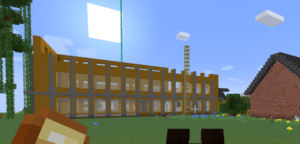
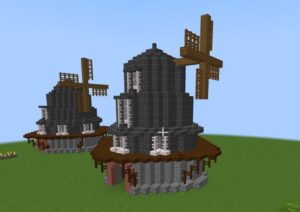
Schloss Schwartstein
The Black Castle, known by some as “the castle that grew legs,” was a source of historical controversy amongst some of the players. Originally built by me, using dark stone gathered from deep beneath the earth’s surface, it resided on top of a small mountain where it may have served as a defensive point near the center of our communal settlement. Construction of the Black Castle was never complete, however. At least not in its original location. One night, a mysterious scoundrel deconstructed the entire fortress, brick by brick, and rebuilt it in a new, more precarious position. Atop a shorter hill, further from the community center, there now stands “the castle that grew legs.” This sparked tense debate by third parties over who was the true owner of the castle: Was it truly the same castle? Does the original builder have a claim over it? Do they still deserve the castle after being so careless as to misplace it? Some, who were outraged by the sudden relocation, tried to escalate the debate into warfare, but a settlement was reached by the opposing parties.
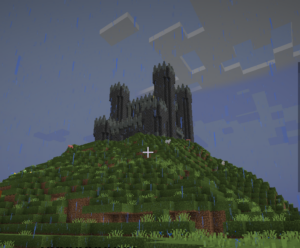
Bonn HBF and Railway infrastructure
Another source of inspiration for some of our infrastructure was Bonn HBF. We had agreed amongst each other that we wanted to build railways connecting our settlements to the community center, which was slowly developing into a marketplace. We also knew that we would need a train station to connect the railways. There was no better option than to recreate the train station we were all so familiar with: Bonn Hauptbahnhof. This group project would take immense effort since we would need copious amounts of hard-to-get resources to make it look authentic to the real thing. Thankfully, I had multiple fellow builders who were willing to import bricks, wood, and various stone types to facilitate construction. Champe, who lives in a far-away forest, took up the ambitious (and expensive) task of creating a triple-gauge railway all the way from his village all the way to HBF. This project would prove quite difficult due to the unthinkable quantity of iron the rails would need. Champe is quite the expert builder, but this task would prove difficult even for him. Thus, resource trading amongst players was common to allow us to finish our individual builds.
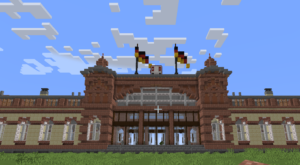
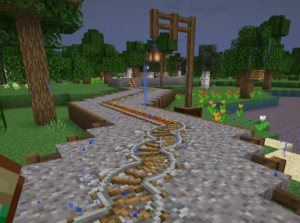
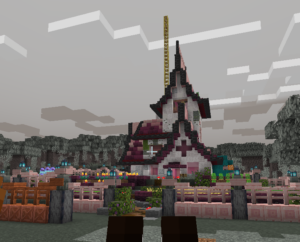
The Marketplace
At a central location relative to all of our settlements, I began construction on the first building that would act as a trading hall. It is home to over 20 of the local villagers, all of whom trade rare artifacts and essential resources in return for emeralds, the local currency. The trading hall facilitates trades with the local villagers as well as with other players. Due to the unique environments we each had access to, we all had different types of resources we were happy to trade with other players to help each other work on our respective projects. Directly behind the marketplace is a partially grounded pirate ship, complete with multicolored sails and a wide range of wood types. This ship was constructed by Ian. Also nearby stands a wood and stone bridge across the river, built by Drew. This connects his settlement to the marketplace for easier access.
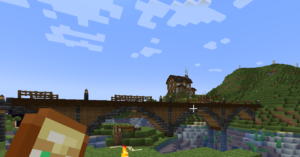
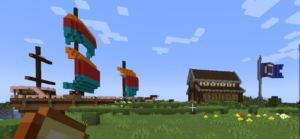
The Jedi Temple
About one kilometer away from our marketplace, I found a large 150m by 150m area that was perfect to start construction of what is quite possibly the largest single structure on the server. Built almost entirely out of red and yellow sandstone and standing at over 100m tall stands a recreation of the Coruscant Jedi Temple. The mining operation required to gather all the stone took multiple trips back and forth from a desert about 2 kilometers away, and left a massive pit in the earth’s crust. The temple was constructed in layers and took a diabolical amount of time to complete. The towers are partially constructed out of gold and copper, which only complicated things as I had to return to mining to gather enough resources.
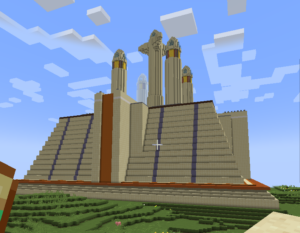
About halfway between the Jedi Temple and the marketplace is a mountainside fortress with a massive cavernous interior, constructed by Bram. Next to it stand two towering industrial farms, connected through underground tunnels built into the mountain.
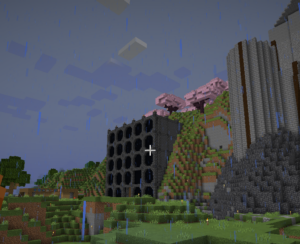
Overall, this server was a whimsical bonding experience. Although the server may become less relevant in the future, our group has truly enjoyed spending our time on it, being creative and taking inspiration from things we’ve seen from our time abroad.

Golly Gee! This seems like a really really really cool project. As the kids would say, “Block Tuah! Craft on that thang!”
-Godspeed,
Winston Smith